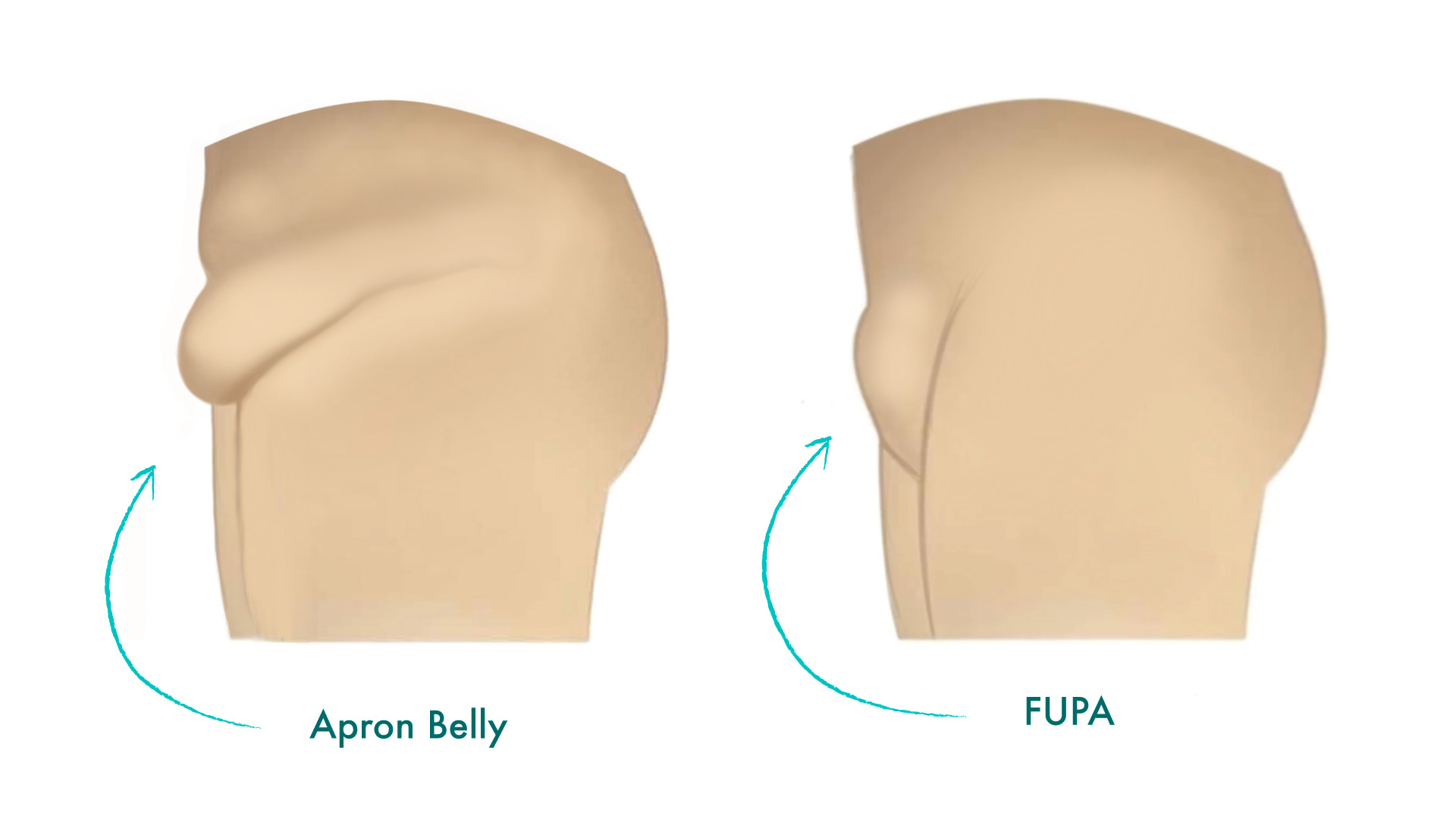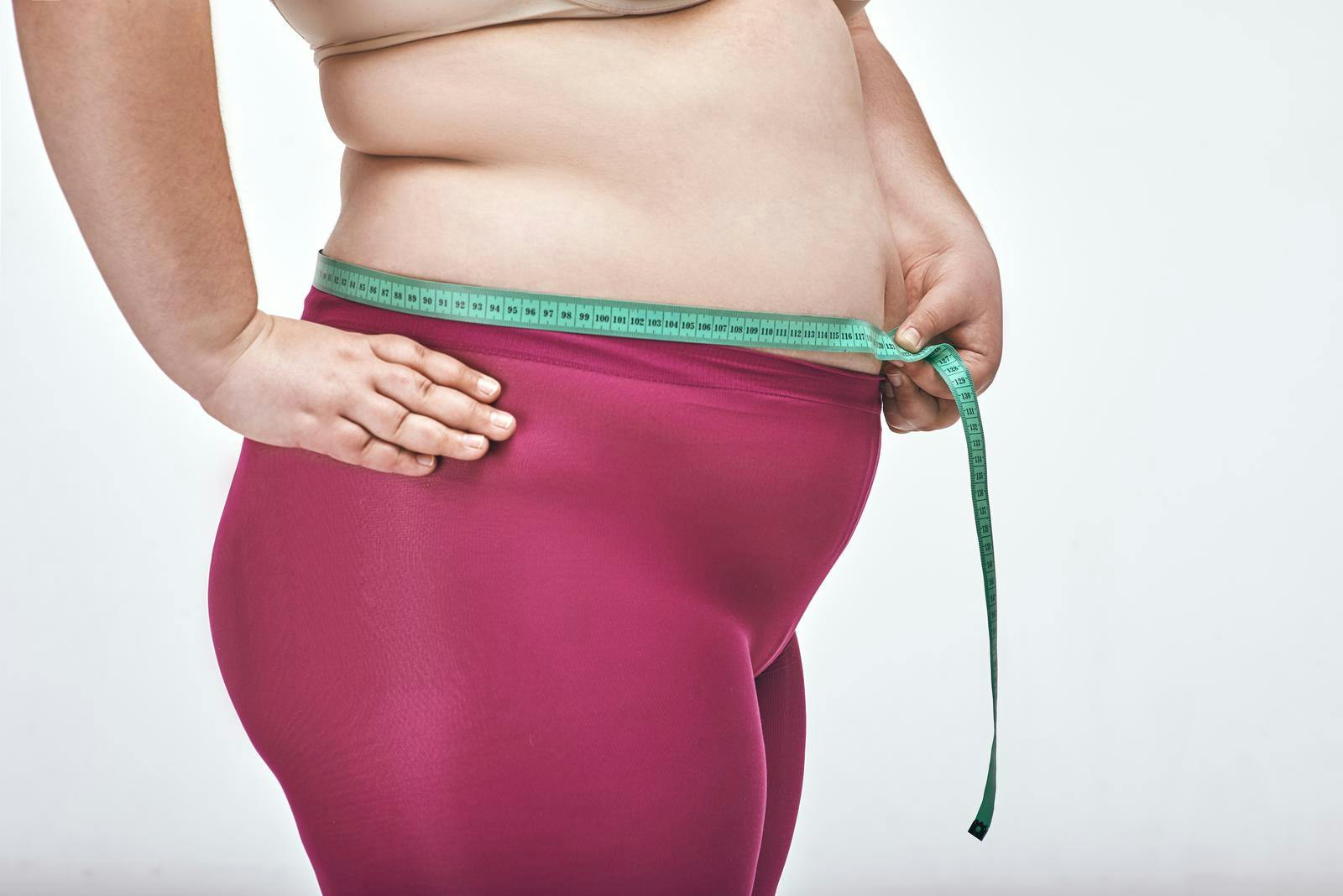What Is FUPA? A Comprehensive Guide to Causes, Treatments, and More

Key points
- Genetics: Your DNA plays a significant role in where your body stores fat. Some people are genetically predisposed to accumulate more fat in the lower abdomen and pubic region.
- Weight Fluctuations: Both gaining weight and losing a significant amount of weight can contribute to a FUPA. Weight gain increases fat deposits, while major weight loss can leave behind loose, excess skin that enhances its appearance.
- Pregnancy and Childbirth: During pregnancy, abdominal muscles stretch, and the body gains weight. Many women notice a FUPA post-pregnancy, especially after a C-section, which can create a "shelf" effect due to scar tissue.
- Hormonal Changes & Aging: As we age, our metabolism slows down, and fat distribution changes. Hormonal shifts, particularly during menopause, can lead to increased fat storage in the abdominal area.
- Diet and Lifestyle: A diet high in processed foods and sugar, combined with a sedentary lifestyle, can contribute to overall weight gain, including in the pubic area.
- Stress: High levels of stress can increase the production of cortisol, a hormone that has been linked to increased fat storage in the belly area.
You may have heard the term "FUPA" in conversations about body image, fitness, or even pop culture, thanks to celebrities like Beyoncé who have spoken openly about it. But what exactly is it, and why does it generate so much discussion?
FUPA is a slang acronym for "Fat Upper Pubic Area." Medically, this area is known as the mons pubis—a mound of fatty tissue that covers the pubic bone. While it's a completely normal part of the human body, its size and prominence can be a source of self-consciousness for some, while for others, it's a feature to be embraced.
This comprehensive guide will explore everything you need to know about FUPA, from its anatomical definition and causes to its potential health implications and the various methods available for managing it, all while embracing a message of body positivity.
What Exactly Is FUPA? A Deeper Look
To understand FUPA, it helps to know the anatomy of the area and what contributes to its appearance.
Defining FUPA: Anatomy and Composition
The term FUPA refers to the accumulation of subcutaneous fat—the soft, pinchable fat located just beneath the skin—in the upper pubic region. This fatty pad serves a protective purpose, cushioning the pubic bone from impact.
According to Dr. Alyssa Dweck, an OB-GYN and author, this fatty tissue on the mons pubis is not only protective but also contains glands that secrete pheromones, which play a role in sexual attraction. The prominence of this area can vary greatly among individuals due to a range of factors.
What Does a FUPA Look Like?
A FUPA appears as a soft, rounded bulge or mound located above the pubic bone and below the lower abdomen. Its appearance can range from a small, slight "pooch" to a more pronounced accumulation of fat and skin. In cases of significant weight loss or post-pregnancy, the area may include loose skin that hangs down, a condition medically known as a panniculus. It's often most visible when wearing form-fitting clothing, such as leggings, swimwear, or tight pants.
 Image Source: Toronto Plastic Surgeons
Image Source: Toronto Plastic Surgeons
What Causes a FUPA?
The development of a FUPA is influenced by a combination of factors. It's rarely due to a single cause, but rather a mix of genetics, lifestyle, and life events.
- Genetics: Your DNA plays a significant role in where your body stores fat. Some people are genetically predisposed to accumulate more fat in the lower abdomen and pubic region.
- Weight Fluctuations: Both gaining weight and losing a significant amount of weight can contribute to a FUPA. Weight gain increases fat deposits, while major weight loss can leave behind loose, excess skin that enhances its appearance.
- Pregnancy and Childbirth: During pregnancy, abdominal muscles stretch, and the body gains weight. Many women notice a FUPA post-pregnancy, especially after a C-section, which can create a "shelf" effect due to scar tissue.
- Hormonal Changes & Aging: As we age, our metabolism slows down, and fat distribution changes. Hormonal shifts, particularly during menopause, can lead to increased fat storage in the abdominal area.
- Diet and Lifestyle: A diet high in processed foods and sugar, combined with a sedentary lifestyle, can contribute to overall weight gain, including in the pubic area.
- Stress: High levels of stress can increase the production of cortisol, a hormone that has been linked to increased fat storage in the belly area.
FUPA vs. Belly Fat: What's the Difference?
While FUPA is a type of abdominal fat, it’s important to distinguish it from general "belly fat," which can have different health implications.
- FUPA (Fat Upper Pubic Area): This is specifically subcutaneous fat located on the mons pubis. For most people, it is primarily a cosmetic concern rather than a direct health risk.
- General Belly Fat: This is a broader term that includes both subcutaneous fat and visceral fat. Visceral fat is located deep within the abdominal cavity, surrounding vital organs. High levels of visceral fat are dangerous and strongly linked to serious health conditions like type 2 diabetes, heart disease, and certain cancers.
Understanding this difference is key. While you may wish to reduce your FUPA for aesthetic reasons, reducing visceral fat through a healthy lifestyle is crucial for your long-term health.
Can a FUPA Cause Health Problems?
For many, a FUPA is simply a cosmetic issue tied to body image and self-esteem. However, in some cases, a particularly large FUPA or pannus can lead to legitimate medical concerns.
When FUPA is a Cosmetic Concern
The psychological impact of a FUPA can be significant. Feelings of self-consciousness can lead to low self-esteem, anxiety, and avoidance of certain activities, clothing, or intimacy. This emotional distress is a valid reason for individuals to seek ways to manage or reduce their FUPA.
When FUPA Becomes a Medical Issue
A FUPA transitions from a cosmetic issue to a medical one when it causes physical health problems. This most often occurs when there is a significant pannus (a hanging fold of skin and fat). Potential medical issues include:
- Skin Problems: Moisture can become trapped in the skin folds, leading to chronic rashes, chafing, irritation, and fungal or bacterial infections.
- Hygiene Difficulties: Keeping the area clean and dry can be challenging, further increasing the risk of skin conditions.
- Physical Discomfort and Mobility Issues: The weight and bulk of a large pannus can cause back pain and interfere with daily activities like walking and exercising.
- "Buried Penis": In men, an extreme accumulation of fat in this region can envelop the penis, leading to difficulties with urination, sexual function, and hygiene.
If you experience any of these physical symptoms, it's important to consult a healthcare professional.
How to Manage or Reduce a FUPA
If you decide you want to reduce the appearance of your FUPA, a multi-faceted approach is most effective. It's crucial to remember that spot reduction is a myth—you cannot lose fat from just one area of your body. Overall fat loss is the goal.
Lifestyle and Natural Approaches (Diet & Exercise)
The foundation for reducing any type of body fat is a healthy lifestyle.
Diet
Focus on a sustainable, balanced diet that creates a calorie deficit. Prioritize:
- Lean Proteins: Chicken, fish, tofu, and legumes.
- Whole Grains: Oats, quinoa, and brown rice.
- Fruits and Vegetables: A colorful variety for essential vitamins and fiber.
- Healthy Fats: Avocado, nuts, and olive oil.
- Hydration: Drink plenty of water throughout the day.
Exercise
Combine cardiovascular exercise with targeted strength training.
- Cardiovascular Exercise: Aim for at least 150 minutes of moderate-intensity cardio per week. Activities like brisk walking, running, cycling, or swimming help burn overall body fat.
- Core-Strengthening Exercises: While these won't burn fat directly from the FUPA, they will strengthen the underlying abdominal muscles, creating a tighter, more toned appearance. Effective exercises include:
- Planks: Hold for 30-60 seconds, keeping your core engaged and back straight.
- Leg Raises: Lie on your back and slowly lift your straight legs towards the ceiling, then lower them without letting them touch the floor.
- Bicycle Crunches: Engage your obliques and lower abs by bringing opposite knee to opposite elbow in a cycling motion.
- Hip Lifts: Lie on your back with feet flat on the floor. Lift your hips toward the ceiling, squeezing your glutes and engaging your core.
Non-Surgical Medical Treatments
For those with stubborn pockets of fat that resist diet and exercise, non-surgical treatments offer a less invasive option with minimal downtime.
- Cryolipolysis (e.g., CoolSculpting): This procedure uses controlled cooling to freeze and destroy fat cells, which are then naturally eliminated by the body over several weeks. It's best for small, localized areas of fat.
- Radiofrequency Therapy: This method uses heat to destroy fat cells and stimulate collagen production, which can help tighten the skin.
Results from these treatments are gradual and may require multiple sessions.
Surgical Treatments for FUPA
For more significant and immediate results, particularly when excess skin is present, surgical options are the most effective.
- Liposuction: This procedure surgically removes excess fat deposits from the mons pubis through a small tube called a cannula. It is ideal for patients with good skin elasticity.
- Monsplasty (Pubic Lift): This surgery removes both excess fat and skin from the pubic mound. The surgeon makes an incision (similar to a C-section scar) to lift and tighten the area.
- Abdominoplasty (Tummy Tuck): Often performed in conjunction with a monsplasty, a tummy tuck addresses excess fat and skin across the entire abdomen and tightens weakened abdominal muscles.
- Panniculectomy: This procedure is specifically designed to remove a large, overhanging pannus for medical reasons, such as to resolve skin infections or mobility issues.
 Image Source: Moshy
Image Source: Moshy
Body Positivity and Embracing Your Body
It's important to frame any discussion about FUPA within the context of body positivity and self-acceptance. In her 2018 Vogue interview, Beyoncé famously said, "But right now, my little FUPA and I feel like we are meant to be."
This sentiment highlights a crucial point: having a FUPA is normal. Your body is unique, and its shape does not define your worth. The decision to change your body is a personal one. If your FUPA doesn't cause you medical problems or significant emotional distress, there is no pressure to get rid of it. Embracing your body as it is can be a powerful act of self-love.
Frequently Asked Questions (FAQ)
What is FUPA? FUPA is an acronym that stands for "Fat Upper Pubic Area." It refers to the accumulation of subcutaneous fat and sometimes excess skin in the mons pubis, which is the area directly above the pubic bone and below the lower abdomen. It is a common condition that can affect people of all genders.
Is having a FUPA normal? Yes, having a FUPA is completely normal. The mons pubis naturally has a fatty pad to protect the pubic bone, and the amount of fat stored there varies from person to person. It's a common feature for many individuals, and its prominence can change throughout life due to factors like aging and pregnancy.
Can men have a FUPA? Yes, FUPA affects all genders. In men, factors like genetics, weight gain, and aging can cause fat to accumulate in the upper pubic area, sometimes leading to a condition known as a "buried penis" in severe cases.
What's the fastest way to get rid of a FUPA? There is no "fast" or "overnight" natural way to eliminate a FUPA, as spot reduction is not possible. The quickest results come from surgical procedures like liposuction or a monsplasty, but these involve significant recovery time and risks. Sustainable fat loss through diet and exercise is a gradual process.
Does a FUPA go away with weight loss? Weight loss can significantly reduce the amount of fat in the pubic area, making a FUPA smaller. However, if there is loose or stretched skin, especially after significant weight loss or pregnancy, it may not fully retract and could remain visible.
References

About the author
Sofia Rossi, MD, is a board-certified obstetrician-gynecologist with over 15 years of experience in high-risk pregnancies and reproductive health. She is a clinical professor at a top New York medical school and an attending physician at a university hospital.